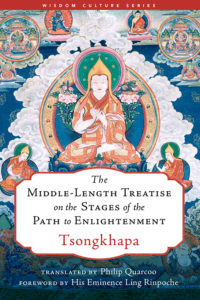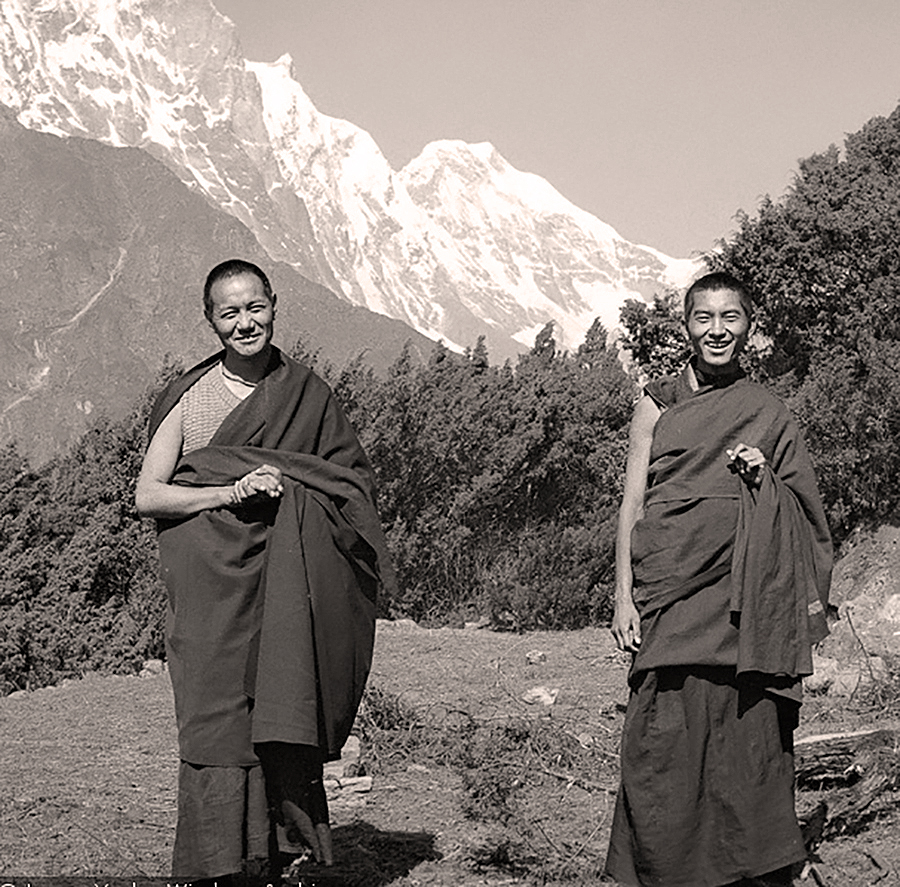
The Wisdom Culture Series
Key Works for The Study and Cultivation of The Mahayana Buddhist Path
The Wisdom Culture Series is published by Wisdom Publications in association with the Foundation for the Preservation of the Mahayana Tradition (FPMT). Under the guidance of Lama Zopa Rinpoche, the series provides English-language readers with key works for the study and cultivation of the Mahayana Buddhist path, especially works of masters within the lineage of Lama Tsongkhapa and the Geluk school of Tibetan Buddhism. “Wisdom culture,” an expression frequently used by Lama Yeshe, is a Dharma culture rooted in wisdom and compassion. The Wisdom Culture Series is intended to support this vision by transmitting the timeless wisdom of the Dharma through authoritative and accessible publications.
“What we normally understand as the meaning of ‘culture’ is the relative mind or spirit, the collective illusions of a certain land or people. It actually has nothing to do with the wisdom truth of Dharma. If we stretch the meaning we could say that Dharma is the ‘culture’ of our progressively developing wisdom. I think the meeting of East and West could be worked progressively towards a finer level of understanding. I think we must work toward a wisdom culture.”
—Lama Yeshe
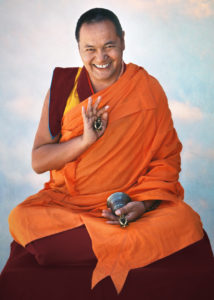 Lama Thubten Yeshe was born in Tibet in 1935. At the age of six, he entered Sera Monastic University in Tibet where he studied until 1959, when as Lama Yeshe himself has said, “In that year the Chinese kindly told us that it was time to leave Tibet and meet the outside world.” Lama Thubten Yeshe and Lama Thubten Zopa Rinpoche, together as teacher and disciple since their exile in India, met their first Western students in 1967. By 1971, they settled at Kopan, a small hamlet near Kathmandu in Nepal. In 1974, the Lamas began touring and teaching in the West, which would eventually result in The Foundation for the Preservation of the Mahayana Tradition. Lama Yeshe died in 1984.
Lama Thubten Yeshe was born in Tibet in 1935. At the age of six, he entered Sera Monastic University in Tibet where he studied until 1959, when as Lama Yeshe himself has said, “In that year the Chinese kindly told us that it was time to leave Tibet and meet the outside world.” Lama Thubten Yeshe and Lama Thubten Zopa Rinpoche, together as teacher and disciple since their exile in India, met their first Western students in 1967. By 1971, they settled at Kopan, a small hamlet near Kathmandu in Nepal. In 1974, the Lamas began touring and teaching in the West, which would eventually result in The Foundation for the Preservation of the Mahayana Tradition. Lama Yeshe died in 1984.
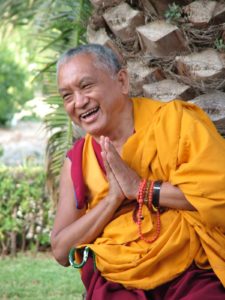 Lama Zopa Rinpoche was a Tibetan Buddhist scholar and meditator who for over 30 years oversaw the spiritual activities of the extensive worldwide network of centers, projects, and services that form the Foundation for the Preservation of the Mahayana Tradition (FPMT) which he founded with Lama Thubten Yeshe. Born in the Mount Everest region of Thami in 1946, Lama Zopa was recognized soon afterward by His Holiness Trulshik Rinpoche and five other lamas as the reincarnation of the great yogi Kunsang Yeshe. Rinpoche was taken under the care of FPMT’s founder Lama Thubten Yeshe, soon after leaving Tibet, in Buxa Duar, India, in the early 1960s. Rinpoche was with Lama Yeshe until 1984 when Lama Yeshe passed away and Lama Zopa Rinpoche took over as spiritual director of FPMT. Lama Zopa died in April of 2023. Discover more of Lama Zopa’s books here.
Lama Zopa Rinpoche was a Tibetan Buddhist scholar and meditator who for over 30 years oversaw the spiritual activities of the extensive worldwide network of centers, projects, and services that form the Foundation for the Preservation of the Mahayana Tradition (FPMT) which he founded with Lama Thubten Yeshe. Born in the Mount Everest region of Thami in 1946, Lama Zopa was recognized soon afterward by His Holiness Trulshik Rinpoche and five other lamas as the reincarnation of the great yogi Kunsang Yeshe. Rinpoche was taken under the care of FPMT’s founder Lama Thubten Yeshe, soon after leaving Tibet, in Buxa Duar, India, in the early 1960s. Rinpoche was with Lama Yeshe until 1984 when Lama Yeshe passed away and Lama Zopa Rinpoche took over as spiritual director of FPMT. Lama Zopa died in April of 2023. Discover more of Lama Zopa’s books here.
LATEST RELEASE
The Power of Meditation
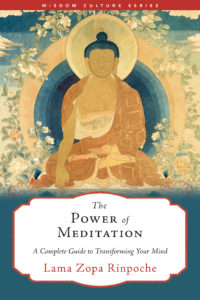 In The Power of Meditation, Lama Zopa Rinpoche offers clear explanations and instructions for the life-changing practice of meditation. From preparatory procedures, such as selecting a space and adopting the proper motivation, to the details of posture and how to focus the mind, Rinpoche offers step-by-step instruction that serves as both a starting point for beginners and a new vantage on familiar techniques for more experienced sitters. In his own direct and plain-spoken style, Rinpoche offers concise explanations for different kinds of meditation, such as shamatha, or calm abiding meditation, and vipashyana, or insight meditation, delineating their specific techniques and applications. And finally, Rinpoche presents tips for bringing our newfound clarity off of the cushion and into our daily lives, making each moment meaningful.
In The Power of Meditation, Lama Zopa Rinpoche offers clear explanations and instructions for the life-changing practice of meditation. From preparatory procedures, such as selecting a space and adopting the proper motivation, to the details of posture and how to focus the mind, Rinpoche offers step-by-step instruction that serves as both a starting point for beginners and a new vantage on familiar techniques for more experienced sitters. In his own direct and plain-spoken style, Rinpoche offers concise explanations for different kinds of meditation, such as shamatha, or calm abiding meditation, and vipashyana, or insight meditation, delineating their specific techniques and applications. And finally, Rinpoche presents tips for bringing our newfound clarity off of the cushion and into our daily lives, making each moment meaningful.
Perseverance
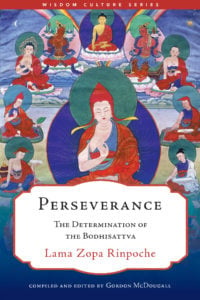 Perseverance, or virya, is also translated as “energy,” “fortitude,” or “vigor.” One of the six perfections, or paramitas, it is one of the trainings of the bodhisattvas and a deeply necessary quality for the Buddhist path. But it’s far from the kind of head-down, stubborn determination the name could imply; instead, it’s joyful energy that enables us to practice. Rinpoche’s commentary is structured around the fifth and seventh chapters of the beloved Guide to the Bodhisattva’s Way of Life by the eighth-century philosopher-poet Shantideva. Interweaving his teaching with Shantideva’s verses, Rinpoche elucidates this prerequisite for enlightenment, explaining what it is and how to cultivate it: guard your mind, gather virtue, work for others—and find incredible joy in these things.
Perseverance, or virya, is also translated as “energy,” “fortitude,” or “vigor.” One of the six perfections, or paramitas, it is one of the trainings of the bodhisattvas and a deeply necessary quality for the Buddhist path. But it’s far from the kind of head-down, stubborn determination the name could imply; instead, it’s joyful energy that enables us to practice. Rinpoche’s commentary is structured around the fifth and seventh chapters of the beloved Guide to the Bodhisattva’s Way of Life by the eighth-century philosopher-poet Shantideva. Interweaving his teaching with Shantideva’s verses, Rinpoche elucidates this prerequisite for enlightenment, explaining what it is and how to cultivate it: guard your mind, gather virtue, work for others—and find incredible joy in these things.
“When we have perseverance, we will have no obstacles, which means obstacles to any happiness, especially to ultimate happiness, the freedom from the oceans of samsaric suffering, and most importantly to peerless happiness, the state of the omniscience that is enlightenment.”
—Lama Zopa Rinpoche
The Swift Path
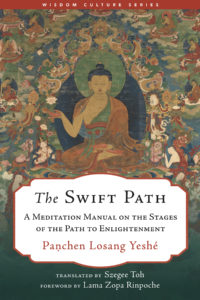 The Swift Path by the Second Panchen Lama has long been heralded in the Geluk school of Tibetan Buddhism as one of the “eight great lamrims,” or works presenting the stages of the path to enlightenment, but it is the last to become widely available in English translation. Composed by a preceptor of two Dalai Lamas, this practical and systematic guide to meditating on the lamrim is based on the Easy Path, a more concise work by the First Panchen Lama. In the Swift Path, Paṇchen Losang Yeshé expands on the earlier Paṇchen Lama’s meditation guide with more detailed instructions on how to generate a clear and profound experience of the key recognitions that allow us to advance on our spiritual journey. These include the recognition of the opportunity afforded by our human existence, both its preciousness and its precariousness, and the way to adopt and live out the practices of a bodhisattva. The guided meditations here make use of a visualization of one’s teacher in the guise of Śākyamuni Buddha to unlock our own innate potential for buddhahood, complete enlightenment, to best benefit humanity and all living beings.
The Swift Path by the Second Panchen Lama has long been heralded in the Geluk school of Tibetan Buddhism as one of the “eight great lamrims,” or works presenting the stages of the path to enlightenment, but it is the last to become widely available in English translation. Composed by a preceptor of two Dalai Lamas, this practical and systematic guide to meditating on the lamrim is based on the Easy Path, a more concise work by the First Panchen Lama. In the Swift Path, Paṇchen Losang Yeshé expands on the earlier Paṇchen Lama’s meditation guide with more detailed instructions on how to generate a clear and profound experience of the key recognitions that allow us to advance on our spiritual journey. These include the recognition of the opportunity afforded by our human existence, both its preciousness and its precariousness, and the way to adopt and live out the practices of a bodhisattva. The guided meditations here make use of a visualization of one’s teacher in the guise of Śākyamuni Buddha to unlock our own innate potential for buddhahood, complete enlightenment, to best benefit humanity and all living beings.
The Power of Mantra
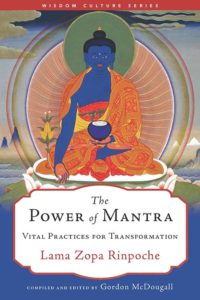 Energize your practice with the potent energy of mantra.
Energize your practice with the potent energy of mantra.
In The Power of Mantra: Vital Practices for Transformation beloved teacher Lama Zopa Rinpoche guides us through the most popular mantras in Tibetan Buddhism: Shakyamuni Buddha, Chenrezig, Manjushri, Tara, Medicine Buddha, Vajrasattva, and more.
A mantra—literally “that which protects the mind”—is a series of Sanskrit syllables that evoke the energy of a particular buddha or bodhisattva. It works as a sacred sound that brings blessings to ourself and others, and as a tool to transform our mind into one that is more compassionate and wise.
In clear and succinct teachings, Lama Zopa shows us why we need different mantras and how each mantra works. He also explains their importance and power, giving specific instructions for practicing them. The exquisite, full-color illustrations of the deities that accompany the text make this book a beautiful guide, one suitable for both beginners and experienced practitioners.
The Middle-Length Treatise on the Stages of the Path to Enlightenment
Tsongkhapa (1357–1419), author of the well-known Great Treatise on the Stages of the Path to Enlightenment and guru to the First Dalai Lama, is renowned as perhaps Tibet’s greatest scholar-saint. A dozen years after writing his Great Treatise, he wrote the Middle-Length Treatise on the Stages of the Path to Enlightenment, presented here in its first complete English translation.
Less than half the length of the Great Treatise, this work similarly presents a systematic overview of the Buddha’s teachings. Tsongkhapa begins by abridging the longer work, distilling its meditations for quicker integration. After recognizing the rarity of our human existence and the great opportunities it affords, he follows with reflections on impermanence, suffering, and the promise of liberation from our past actions, proceeding then to the path of bodhisattvas, whose universal compassion seeks to free every being from suffering. Tsongkhapa gives especially detailed instructions on śamatha, the deep meditative concentration that is a precondition for the highest insight into the nature of reality. The final and largest section, on that very insight, is unique to this work, particularly Tsongkhapa’s presentation of conventional truth and ultimate truth. Beginners and longtime practitioners alike will cherish the clear guidance from one of Tibet’s great luminaries.

